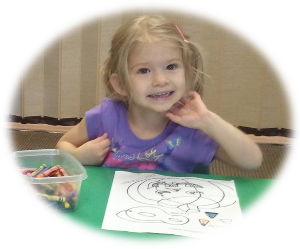
Three-year-olds work on coloring and other artwork to help develop fine motor skills. (Hope you have a big door on your refrigerator.)
The following are the objectives for the academic year that the daily, weekly and monthly lesson plans are based on. These core objectives are developmentally appropriate for the average three to four-year-old. Regular staff meetings are held during the year to discuss if the objectives are being met, and changes to the lesson plans are implemented if necessary. Discussions are also held to develop alternative activities and strategies if any individual falls outside the normal range of development during the year. The objectives are subdivided into three areas, cognitive, social and motor skill development.
Cognitive Development
- Demonstrate the ability to recognize the child’s first name in print.
- Correctly identify at least ten letters of the alphabet in print.
- Correctly identify at least five shapes.
- Correctly identify at least seven colors
- Recite in correct sequence the numbers one to ten
- Correctly separate out five objects from a larger group of objects that are all similar in size shape and color.
- Recite the seven days of the week in the correct sequence beginning with Sunday.
- Demonstrate the ability to place in correct categories objects of similar size (large versus small), similar type (such as birds versus fish) similar color and similar use (things used in the kitchen versus things used in the garden).
- Answer basic questions regarding the content of a story read to them demonstrating an understanding of the plot, characters and story line.
- Demonstrate successfully the ability to complete a task with three concurrent directions given at the start of the activity.
The method for fostering the cognitive development of each child is through weekly thematic presentation of concepts during project and circle time. Each theme offers the opportunity to promote numeracy and literacy learning in a varied way to engage the child. Daily calendar, weather review, and alphabet flash card review offer the necessary repetition to foster cognitive development of basic skills.
The method for determining if the desired objectives have been achieved is through tests using flash cards and student/teacher interviews. A standard test is given at the beginning of the year and at the end of the school year to each student for comparison. Results are then presented to the child’s parent or guardian at the end of year parent-teacher conferences. Any irregularities in cognitive development are brought to the attention of the parents immediately.
Social Development
- Demonstrate pro-social behavior including the ability to share, take turns, forgive, apologize and show consideration for others feelings.
- Use good manners on a regular basis without prompting. The proper etiquette to include, saying please, thank you, and excuse me.
- Play cooperatively in both small and large group activities. Behavior should include; taking turns, sharing, participating in dialogue, and participating during “free” play time with others beyond parallel play.
- Demonstrate the foundations of the necessary skills to manage aggression, anger and frustration.
The method for promoting positive social development of the children in the class is through positive reinforcement of proper behavior, verbal reminders of good social behavior, teachers setting a good example of behavior and reading stories, doing activities and initiating discussions that touch on the concepts of pro-social behavior.
The method for testing if the objectives are being met is through observation of general class behavior and constructing situations that can be monitored to record the specific social interactions. Summaries of each student’s social development are included in the final school report. Any irregularities in a child’s social development are brought to the attention of the parents immediately.
Fine and Gross Motor Skill Development
- Perform fine motor skill activities with proper technique and accuracy, including the use of pencils, scissors, glue bottles, paint brushes and project materials
- Demonstrate proficiency in using small manipulatives, including counting beads and disks, threading cards, magnets, Lego and building blocks.
- Use the computer mouse correctly to execute simple computer activities.
- Perform gross motor skill activities including throwing and catching a soft rubber ball, jumping on two feet forward and backward, walking on a balance beam and galloping.
- Demonstrate the necessary coordination to clap in time to simple music, kick a ball, and hop on one foot.
The method for gross motor skill development is through both structured physical activities and unstructured playtime in the gym and playground. The method for fine motor skill development is through performance of a variety of projects in the daily curriculum that utilize materials including scissors, paint, glue pencils and crayons. During directed class time play, a variety of small manipulatives are made available for the children to work with.
The method for testing the effectiveness of the curriculum in reaching the desired objectives is through collecting and comparing samples of work completed throughout the year and end of year worksheets and skills tests that demonstrate the abilities and accuracy of the child in task performance.
By assessing each student at the beginning and end of year we are able to provide parents with detailed information regarding their child’s progress, areas of strengths and areas requiring further development. Detailed information is vital when making decisions pertaining to the child’s transition to pre-kindergarten, the possible need for any early intervention and most importantly, insuring we are engaging and challenging each child so that they may develop to their full potential.